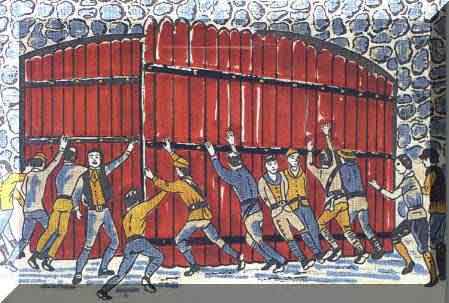|
Richard Talbot, the Earl of Tyrconnell, acted as James II's viceroy
in Ireland and was anxious to ensure that all strong points in the country
were held by garrisons completely loyal to the Catholic cause.
By November 1688, only the walled city of Londonderry had a Protestant
garrison and, as a result, the Earl of Antrim was ordered to replace it
with a more reliable force. Alexander MacDonnell, third Earl of Antrim,
despite his age of 76, keenly responded to this command but wasted valuable
time searching for men who were six feet tall or more.
It was not until the first week in December - the week William of
Orange landed in England - that he set out for Derry with around 1,200
men, most of them 'Redshanks', Highlanders and Islanders who got their
name from wading with bare legs through rivers in the coldest weather.
On 7th December 1688, Lord Antrim's army appeared at the Waterside,
on the right bank of the Foyle, and began to cross the river in boats.
Then thirteen young men, most of them apprentices, drew their swords,
ran to the mainguard and grabbed the keys. They raised the drawbridge
at Ferryquay gate and closed the gate before the astonished Redshanks
who were then only 60 yards away. Suspected of being a secret supporter
of James II, Colonel Lundy was ousted from his post as Governor and replaced
by Major Henry Baker and Rev George Walker. The city had a good quantity
of weapons and ammunition, having recently been supplied by the vessel
Deliverance, but Derry's population of some 2,000 had been swollen by
around 7,000 soldiers and perhaps as many as 30,000 refugees. King James
joined his besieging army and on 18th April advanced towards the walls
and offered terms. He was greeted with cries of 'No surrender!' and a
fierce and sustained barrage of shot and ball. Just out of range, James
sat motionless on his horse for several hours in the pouring rain.
Then at the entreaty of his French advisers the king returned to Dublin.
At the end of May a siege train of heavy guns sent by James arrived and
the bombardment of the city intensified. The rain of mortar shells, bombs
and cannon balls never threatened to breach the walls, but it did exact
a heavy toll of life from the densely packed defenders. Major-General
Percy Kirke had arrived at the mouth of Lough Foyle on 11 June but for
six weeks he refused to risk the Jacobite guns of Culmore fort. A stiff
note from William of Orange's general, the Duke of Schomberg, arrived
ordering a relief attempt forthwith and, helped by a flowing tide and
the fact that the Jacobite gunners were drunk, three vessels made their
way up the Foyle led by the Mountjoy which broke a boom of logs and chains
to get up to the walls on the evening of 28 July 1689. The arrival of
provisions for the defenders caused the Jacobites to withdraw. Lasting
105 days, this was the last great siege in British history.
The period from 1688-9 is commonly known as the Siege of Derry but
to gain a full understanding of this period, the main events have to be
examined fully.
On November the 5th 1688 William of Orange landed in England to launch
his challenge against King James II for the throne of England. However
as William became increasingly successful the Protestant minority in Ireland
began to fear for their safety. When the Comber Letter of the 3rd December
was discovered, the fears of a repeat of the Protestant massacres of 1641
began to grow across Ireland, but particularly in Londonderry.
On the 7th of December 1688 as the Earl of Antrim approached Ferryquay
Gate, with his mainly Catholic Army which had remained loyal to King James,
Thirteen young Apprentice Boys closed the Gates on the advancing Jacobite
Army. After the Jacobite Army retreated, the Protestants of Londonderry
declared their loyalty to King William on the 24th of March 1689, which
was a brave decision as King James had landed in Ireland on the 12th March
1689, with his French Army.
On April the 15th Protestant fears in the city increased as King James's
Army approached the city which had became a refuge for Protestants from
the area surrounding the City. On the 18th of April 1689 King James and
his army came towards Bishops Gate and demanded entry to the City. The
defenders of the City fired upon the Army of King James which marked the
start of the Siege of Derry. The next day Lundy, whose loyalty was in
doubt was forced to leave and he was replaced as Governor by Major Baker
and Reverend Walker.
During the siege the City was surrounded by the Jacobite Army that was
loyal to King James, Most of their men were French, supported by the Catholic
Irish. The City was defended by over 7000 men at the start of the Siege.
The City's walls made it difficult for the Jacobite forces to attack the
City, which is why King James decided to lay siege to the City hoping
that the Protestant defenders of the City would Surrender. The Jacobite
Army had set up two attacking positions on the Waterside, using their
gun batteries to fire across the River Foyle into the walled City.
French Soldiers were also based in the Creggan area where they would fire
across the Bogside area into the City itself. On the 4th of June 1689
the 2nd Battle of the Windmill took place when the Williamite forces recaptured
the Windmill on high ground overlooking Bishops Gate, this victory was
of great strategic importance.
The City's walls where protected by 20 long range Cannons including the
famous 'Roaring Meg'. Two guns had also been placed on top of the Tower
of the Cathedral which helped to inflicted Damage on the Jacobite forces.
The attacking forces also used Siege Guns to try and weaken the City walls
which luckily had been reinforced in the 1640's. Throughout June and July
1689 the City came under constant bombardment causing much damage and
many deaths.However batch armies were suffering shortages of artillery
and the Williamite forces resorted to making Cannonballs of Brick coated
with Lead. Despite all their hardships the Williamite Army would not surrender
and once the City was relieved the Jacobite forces camped outside the
walls quickly retreated.
The people of the City experienced extreme hardship during the Siege.
There were over 10,000 people inside the walls at the start of a 105 day
Siege. The Siege had not been planned and as a result the people of its
City and it defenders had failed to build up sufficient stores of food,
materials, and ammunition to supply the demands of the City for even a
short lived Siege.
There were over 7000 Soldiers and 350 Officers to defend the City and
from the start of the Siege they organised rationing of all food supplies.
However as the Siege became more prolonged the amount of food rationed
daily Gradually declined by July 1689 conditions inside the City were
becoming desperate with the City coming under increasing attack. There
was no sign of action by Captain Kirkes relief Force. Disease was spreading
rapidly inside the overcrowded City with the young and old becoming usual
victims amongst the malnourished population.
Although the Army had rationed the food for themselves and the Citizens
of the City by the 27th of July Conditions had become so desperate that
anything that was edible had become a valuable commodity the population
of the city had almost been halved and the people had reached a point
where virtually no food supplies or ammunition remained inside the besieged
City. The relief of the City when the Phoenix docked at Shipquay Gate
which was welcome rapturously by a starving population. The suffering
and starvation endured has supported the principle epitomised by the Protestant
settlers of 'No Surrender'.
As conditions in the City worsened the spirits of the beleaguered Protestant
settlers of Londonderry must have been made raised when a relief force
sent by King William arrived in Lough Foyle on the 11th of June 1689.
However the ship under General Kirke set up camp on Inch Island, the ship
would not approach the City, due to the boom that had been placed across
Lough Foyle near the location of the present day Foyle Bridge.
To the frustration of the settlers who were experiencing extreme hardship
the relief force which had been seen from the City walls made no effort
to break the boom for six weeks. General Kirke had been very reluctant
to attack, which had intensified discontent amongst his Officers especially
the Commander of the Mountjoy, Captain Browning a Native of Londonderry.
On the 28th of July 1689, General Kirke finally sent his small force of
three Merchant ships carrying vital supplies, two 50 toners the 'Phoenix'
and the 'Jerusalem' and the barge 130 ton the 'Mountjoy' these three ships
were protected by only one warship the HMS Dartmouth. At 7 O'clock that
evening the ship moved towards the boom to relief the watching settlers
of Londonderry, who had just been given a rousing sermon of encouragement
by the Rev. Walker. Under hostile fire from the French soldiers at Culmore,
fort the Mountjoy tried to break the boom. However it was a small longboat
which actually broke the boom allowing the three merchant ships to make
there way towards the City were they arrived at 10 O'clock that night
Captain Browning Lay dead on the deck of the Mountjoy in sight of his
birth place. By the 31st of July the Jacobite Army had retreated and the
105 day Siege was over.
|



![]()